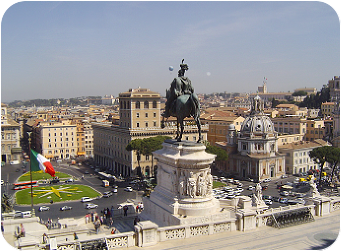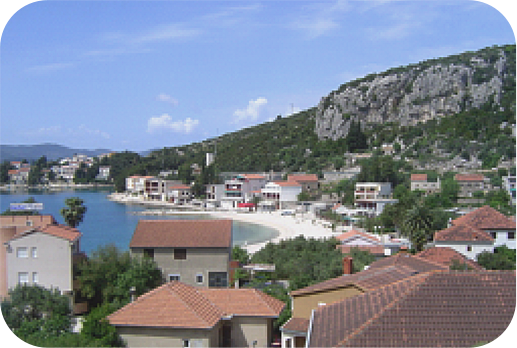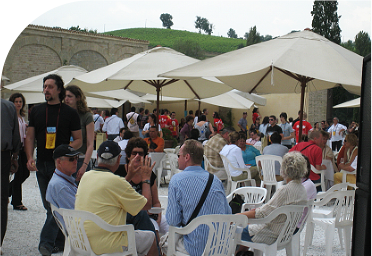Tales of Big Julie and Foraging the Forum There is something about pondering the Forum…
Sliding towards Slovenia
Download a PDF Version of this article
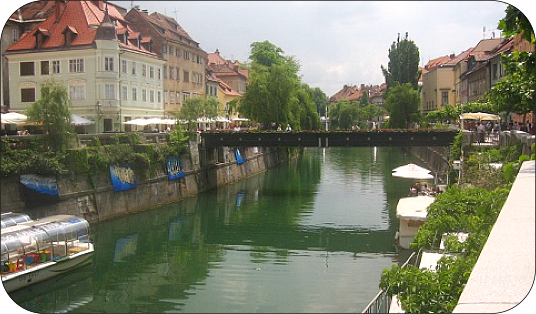
Exiting Rovinj on the excellent Croatian bus service motoring easily through the green countryside of the Istrian peninsular toward Ljubjlana via Italy requires two border crossings. A form of efficiency Yugo style existed as the Slovenian control demanded all bags be brought outside and opened for inspection even though it was a cursory glance at best. Small glimpses of the coastline are visible and in next to no time the bus was in Trieste which is the connection point for Slovenia.
Departure time provides space for a whistlestop tour of the city and escape from the collection of drunks domiciled inside the bus station on their weatherproof sipper seats. Tour du Trieste reveals an atypical Italian city in the dreaded grip of siesta severely limiting spending capacity but nurturing some good homely cafes on statue saturated piazzas. Carbo loading Italian style on the lunchtime special fixed price menu sometime throws up a culinary gem when least expected so the stop was not wasted. In no time the bus was climbing the hilly suburbs above Trieste into alpine vegetation no doubt exhausting the driver as he took a 30 minute unexplained break after 20 minutes driving leaving passengers to sit in the bus and contemplate their navels.
The road trip into Slovenia is through green pastures, conifers, neat housing on small plots amidst a background of high mountains, scenic valleys until finally arriving at the bus station not far from the town centre. Ljubjlana in May is full as Europe wakes up to this most unassuming and friendly capital and accommodation roulette commences in the cheaper end of the flashpackers market. The madcap full on place to stay is the old military prison called Hostel Celica (‘Selechia’) unique restored cells as rooms but was fully booked other than dormitories. The staff understood the reticence of older trippers to communally bunk and do their best to enquire at the Park Hotel nearby which has hotel rooms and 2 floors of hostel on the upper floors. The Lonely Planet had a less than salubrious write-up but a room on the 12th Floor with toilet is a haven passed easily by the health police at E20 pp. Room is a four bunker but the management was ok on a three night sole ownership and informed that the hotel extends a gratis internet connection for 15minutes. This is the equivalent of a YMCA penthouse with no towel changes and makeup own beds but no discrimination of the wealth deprived is practised as the E 80 rooms share the same free brekkie in the dining room. The Park hotel has its share of German and Russian tour groups and the two lifts suffer groanmogrifacation as the fatzinkrammers cram the lift whilst marching to and fro to tour destinations. A Noosa Heads T Shirt shone out amidst the Siberian safari suits and soon elicits a ‘gidday you from Oz’ forging the eating and drinking companions for that nite.
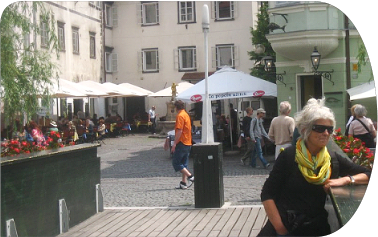 Lubi-town is possibly the smallest Capital, (population 280,000) in Europe but the fluency in English of anybody below 30 years old is complete and every opportunity to help with any enquiry is met with pleasure. The city wakes to a crisp morning and the market along the riverbank from the Four Dragons Bridge to the Triple Bridge is the best seen in Croatia and known parts of Italy. The market has both fixed and collapsible sectors and is sluiced by high pressure hoses at night so the polished tarmac is ready yet again by the next day. The vegetables tiered in barrows are gigantic, redolent of slow maturation, interspersed with clothing venders and other merchants spread about the square. The shoppers wander down the riverbank beside the meat vendors domiciled in fixed buildings followed by delicatessens and shops of nuts and dried fruit. All around is the Slovene café scene a raft of one drink table sitters, in deference to the Italian ideal of charging extra to sit, as they seem to encourage the client to squatting rights. Maybe nothing Italian should be mentioned as the fascists had taken the country in World War Two and strung a 32 kilometre barbed wire enclosure around the complete city.
Lubi-town is possibly the smallest Capital, (population 280,000) in Europe but the fluency in English of anybody below 30 years old is complete and every opportunity to help with any enquiry is met with pleasure. The city wakes to a crisp morning and the market along the riverbank from the Four Dragons Bridge to the Triple Bridge is the best seen in Croatia and known parts of Italy. The market has both fixed and collapsible sectors and is sluiced by high pressure hoses at night so the polished tarmac is ready yet again by the next day. The vegetables tiered in barrows are gigantic, redolent of slow maturation, interspersed with clothing venders and other merchants spread about the square. The shoppers wander down the riverbank beside the meat vendors domiciled in fixed buildings followed by delicatessens and shops of nuts and dried fruit. All around is the Slovene café scene a raft of one drink table sitters, in deference to the Italian ideal of charging extra to sit, as they seem to encourage the client to squatting rights. Maybe nothing Italian should be mentioned as the fascists had taken the country in World War Two and strung a 32 kilometre barbed wire enclosure around the complete city.
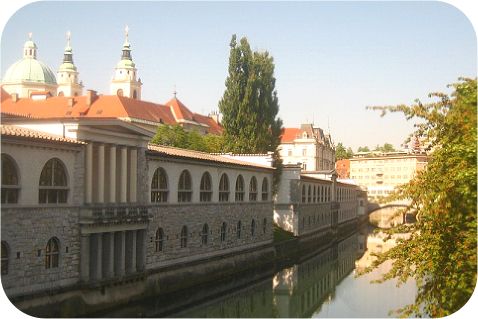 The best way to get acquainted with most capitals is to take the “Red Bus” tour but in Ljubljana’s case the equivalent is an open boat tour on the river beneath the Triple Bridge. The main precincts are easily remembered as old town square; town square and new town square are all within 500 meters so the history lesson is Ljubjlana done over in half an hour. Historically the buildings are not as old as other parts of Europe due to the original wooden structures being replaced by sturdier models in the 17th Century. The sites from the boat are enchanting and the city revels in the love of poetry and architecture but treasures its musical background with a great passion.
The best way to get acquainted with most capitals is to take the “Red Bus” tour but in Ljubljana’s case the equivalent is an open boat tour on the river beneath the Triple Bridge. The main precincts are easily remembered as old town square; town square and new town square are all within 500 meters so the history lesson is Ljubjlana done over in half an hour. Historically the buildings are not as old as other parts of Europe due to the original wooden structures being replaced by sturdier models in the 17th Century. The sites from the boat are enchanting and the city revels in the love of poetry and architecture but treasures its musical background with a great passion.
The young Slovenian girl who narrated the tour was the grand child of Anna the model for the nude statue in Preseren Square named after France Preseren the foremost romantic poet. Preseren was 33 and fell in love with Julija 16 but her mother married her off to a rich merchant to thwart this romance leaving him forever to mourn his lost love. The square named in his honour has his statue gazing onto the bas-relief of Julija and his sonnets make up the Slovenian National anthem and his death the national holiday on Feb 8th.
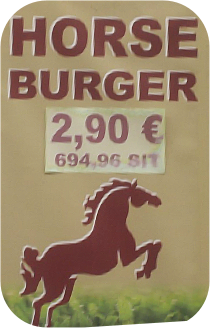 This city of art and cultural passion pops up variety in unexpected places but the catalyst is cobblestone Preseren Square as the chill of evening reveals male and female nude models posing for artists over a 3 hour period for charcoal impressions. In a weird sense of incongruity strung up high across them was an ariel bombardment of white fibreglass humanoids dive bombing the square. People movement increases markedly as night falls and groups of young people wander down to the river banks to start a form of seated passigiata and groups of youth in black tees gathered in the parks. Throw the student graduation time into this mix with the fashion of blowing high pitched whistles and the synchronicity of normal city life is not found much elsewhere.
This city of art and cultural passion pops up variety in unexpected places but the catalyst is cobblestone Preseren Square as the chill of evening reveals male and female nude models posing for artists over a 3 hour period for charcoal impressions. In a weird sense of incongruity strung up high across them was an ariel bombardment of white fibreglass humanoids dive bombing the square. People movement increases markedly as night falls and groups of young people wander down to the river banks to start a form of seated passigiata and groups of youth in black tees gathered in the parks. Throw the student graduation time into this mix with the fashion of blowing high pitched whistles and the synchronicity of normal city life is not found much elsewhere.
Posters are strategically advertising all forms of entertainment from Laibach the legendry Wagnerian rock group, puppetry, local folk groups and concerts by the Slovenian Philharmonic Orchestra.
The Orchestra is based at the Academia Philharmonicorum along the riverbank and was established in 1701 one of the oldest in Europe with a special series of performances throughout May. A presentation from the Akademije Za Glasbo with prodigies of cello, flute, double bass performing solo with the orchestra brought out the Musical glitterati in force accompanied by the shouts of bravo from the majority of young attendees. A special performance came from Maja Savnik in a spellbinding long session as she walked her way around the violin with a smile and demeanour that was almost rock starish. Slovenian society with mid European values inherit a maturity in performance arts that are an integral part of community life casting an allure for all visitorsLjubljana Fort is the omnipresent structure hovering over the town and in its many incantations forms a part of Slovenian national culture and is almost a besieged tourist site in its own right. Beginnings in the bronze age, birth place of a German king, home for 5 centuries for the Habsburgs , a prison ,a ‘Castle Republic’ for 5000 of the lower classes before reverting finally in 2000 to the Ljubljana Festival. A cable car provides easy access to cafés and vantage points over the city and then one can meander through the trees back down to the market square providing a consummate overview of the area filling out locations and visiting points.
This is a town of bridges from the triple bridge which connects the old part of town with the new town square to the four dragon’s bridge which has two dragons at either end. The locals tell a tale that proscribes the legend whenever a virgin crosses the bridge reputedly the dragon tail wags so free love lurks undoubtedly as at no stage did I see a movement.
Churches abound usually of Italian origin but the most astonishing door at the Church of St Nicholas has the carved bronze depictions of 5 popes exposed onto the outside like a macabre death watch.
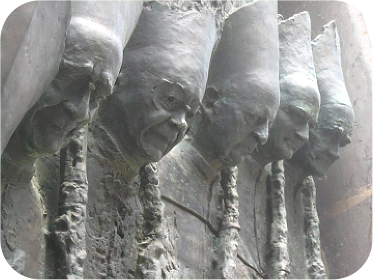
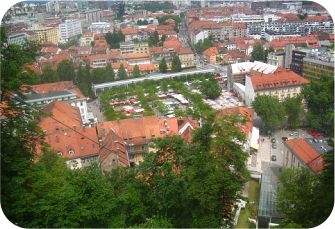
The food is of Austrian derivation although the ajvar and relishes from throughout the Balkans add structure to every protein laden platter as the inevitable healthy meat portions abound. The student haunt of Bacchus restaurant, café, nightclub and any other nomenclature of drink service was passed on as the best value in Ljubjlana and the meal de jour would have fed most of the Sudanese army.
This is a town of cafes and summer must be mayhem as the chill of night did not stop every seat being utilised. Patrons ate, drank and chattered as barstools were perched along the stonewalls of the river plus tables were manned outside every building as music saturated the surrounds.
No trip to Slovenia is complete without the obligatory trip to Bled and Bohinj (‘Bokhin’) almost the symbols of every tourist postcard or poster that represents the country. The bus or train connections are easily accessible and no problems are insurmountable as all staff speak English and make efforts to promote goodwill. The bus takes off every hour for Bohinj and is reached in two and half hours passing through Bled on the way so that one can stop and catch a return after walking the park. There is an Austrian or Swiss feel about the place with lodges and hotels on a flyfishing river and hiking tracks to waterfalls through the alpine vegetation. The ubiquitous disappearing bus driver struck again 30 minutes mid trip into a hotel for some sort of sustenance but at least a good pivo from the spina (beer on tap) is available to pass the time. The usual nonchalant commute worthy of the vista commences slowly back down the valley past the cable car that soars into the mountains to the closed ski fields and into Bled.
Every photo of Bled does it justice and the chocolate box scenery around the lake is a gathering point for the myriad tourist buses with vantage Villas gathering the well heeled into their bosoms on the waters edge. The best view is to walk the 7 kms around the lake at whatever pace suits stopping off in varied cafes and drinking haunts to contemplate the view.
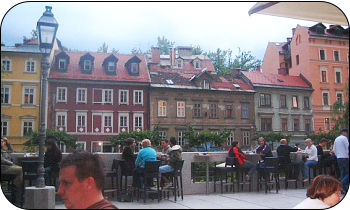 The scene competes with itself as the different hues and colours of the lake takes in the dappled interplay of the background changes. Light, trees, churches, towers create divertive backdrops of reality but Bled will never bleed like other tourist icons as the natural wonderment is unable to be enhanced further by the intrusion of man. It is a retroactive experience which lights up the primordial urge to get to the next photo op and wonder if Neanderthal man had a few digital thoughts as he marrowed out the odd mammoth whilst pondering future church sites.
The scene competes with itself as the different hues and colours of the lake takes in the dappled interplay of the background changes. Light, trees, churches, towers create divertive backdrops of reality but Bled will never bleed like other tourist icons as the natural wonderment is unable to be enhanced further by the intrusion of man. It is a retroactive experience which lights up the primordial urge to get to the next photo op and wonder if Neanderthal man had a few digital thoughts as he marrowed out the odd mammoth whilst pondering future church sites.
The small church on the island dates back to the 10th century, but the present building was built in the 17th century.
According to local tradition, a husband who can carry his newly married bride the 99 steps up from the dock into the church will be ensured a happy marriage, and ringing the bell in the church will fulfill one of your wishes. The bier halls on the lake road were as busy as a hoffbrau haus on Hitler’s birthday particularly with the Vulcan’s motor cycle club filling the environs of the grounds contemplating culinary heaven. Walking leads to the search for food back up in the sedate setting of the village but nothing can dilute the beauty of the spring flowers and foliage in a kaleidoscope of retro colours.
Bled castle is perched 150 meters above the lake and is first mentioned in 1004 making it one of the earliest castles in Slovenia. The castle is a tourist attraction with historical printing presses, early excavations of the ramparts capped out by great views of the Julian Alps and all parts alpine.
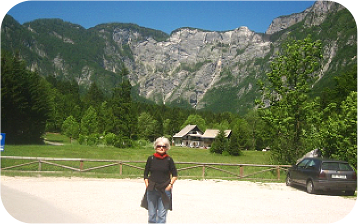
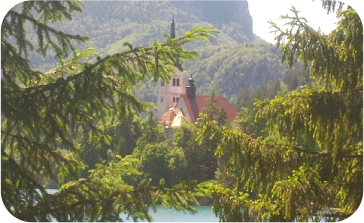
It is an easy day’s travel to these parts and in a brief tour Slovenia allows a glimpse into its psychology and it explains why subjugation by Tito was never complete. The pace of life is sedentary, serene and the ease of slipping into town makes one feel like a perennial Slovene traveller as no overt pressure seems to intrude.

